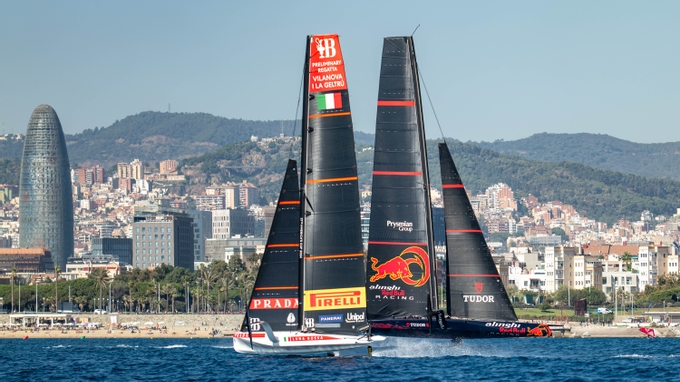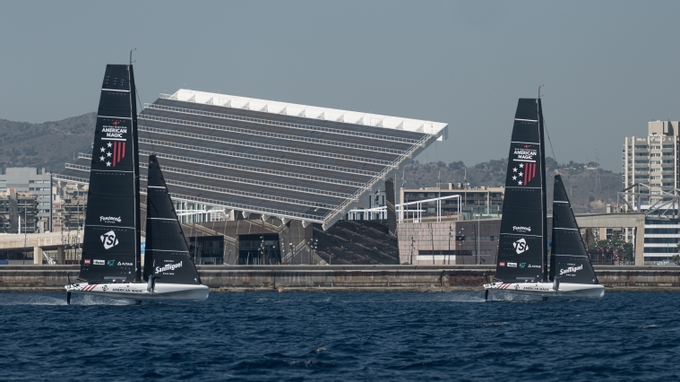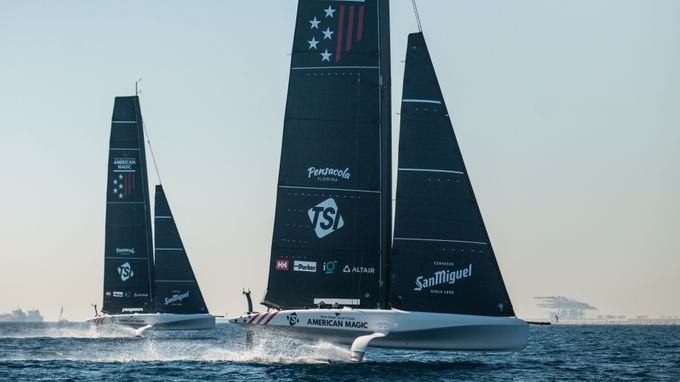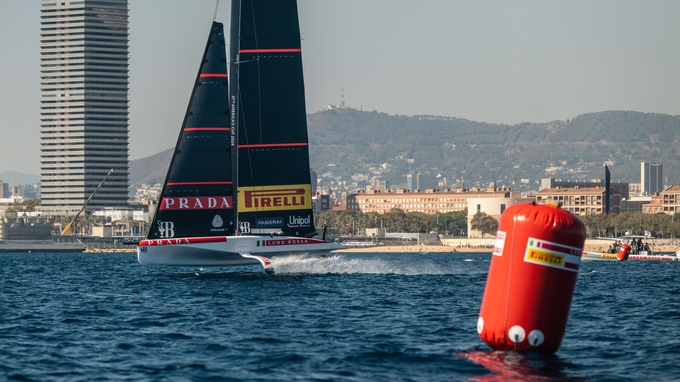PRECISION SAILING IN PERFECT BARCELONA
A glistening Mediterranean greeted all six teams of the 37th America’s Cup today with high-twenties temperatures and a beautiful building afternoon southerly ‘Garbi’ that allowed the sailors to perfect their accuracy and hone their techniques. It’s a big month for the teams. This is the time of the America’s Cup Match and everyone is pairing historical meteorological data to what they see and feel on a daily basis to try and find both design and technique conclusions.
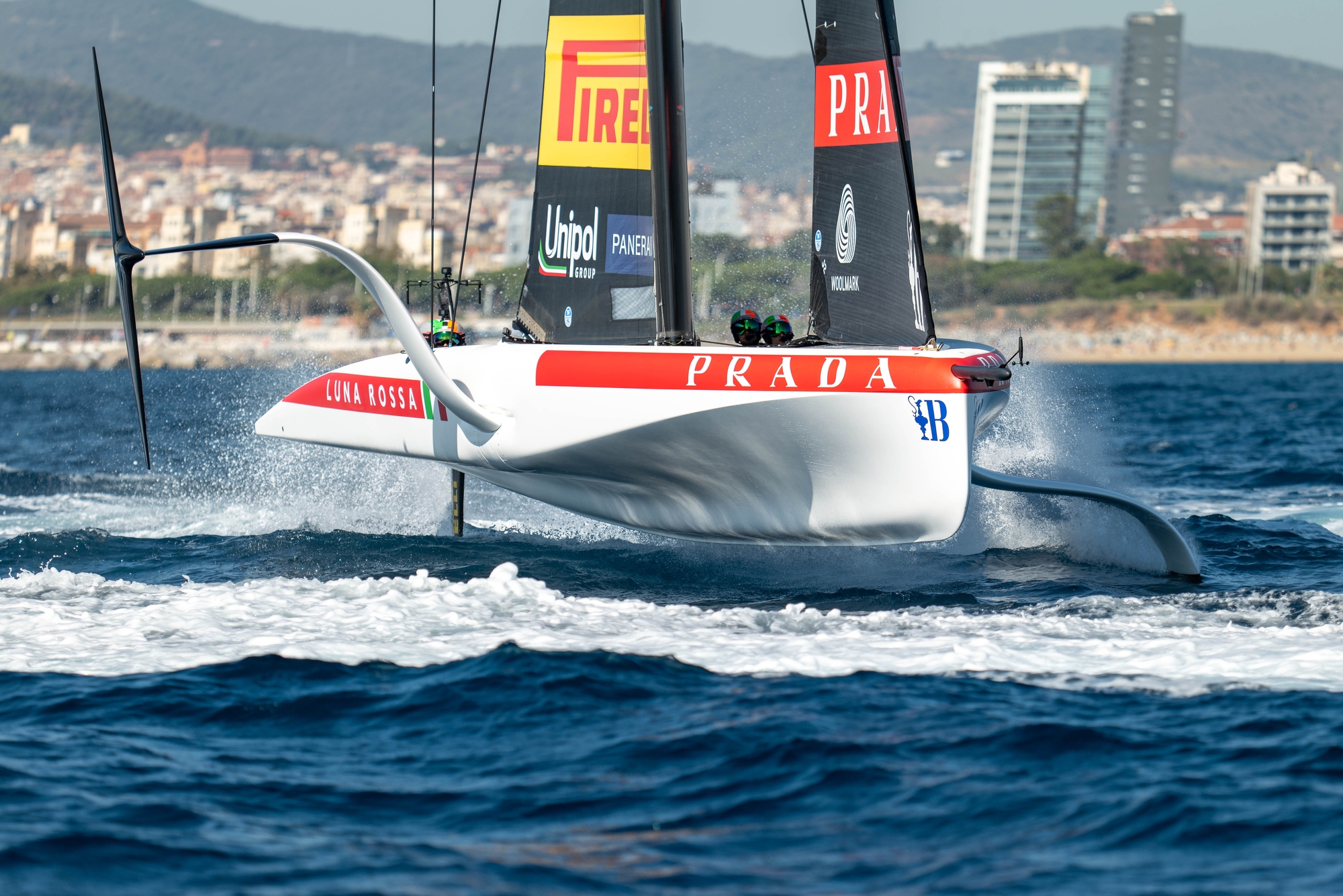
It was a rare and welcome opportunity afforded by Luna Rossa Prada Pirelli to allow a Recon Team to follow their AC40 practise on this, their third day of a ten-day training block as the Italian team fine-tune ahead of the next Preliminary Regatta in Jeddah, Saudi Arabia at the end of November. Interestingly, the Italian next-gen superstars of Ruggero Tita and Marco Gradoni were handed the wheels for an intense afternoon of starting practise where in total, the team executed no less than 17 starts. Even more interesting was that 10 were on starboard off the line whilst 7 were on port and with a chase boat acting as the starboard tack crosser on those port tack starts, it's clear that Luna Rossa saw something in Vilanova that has piqued their attention.
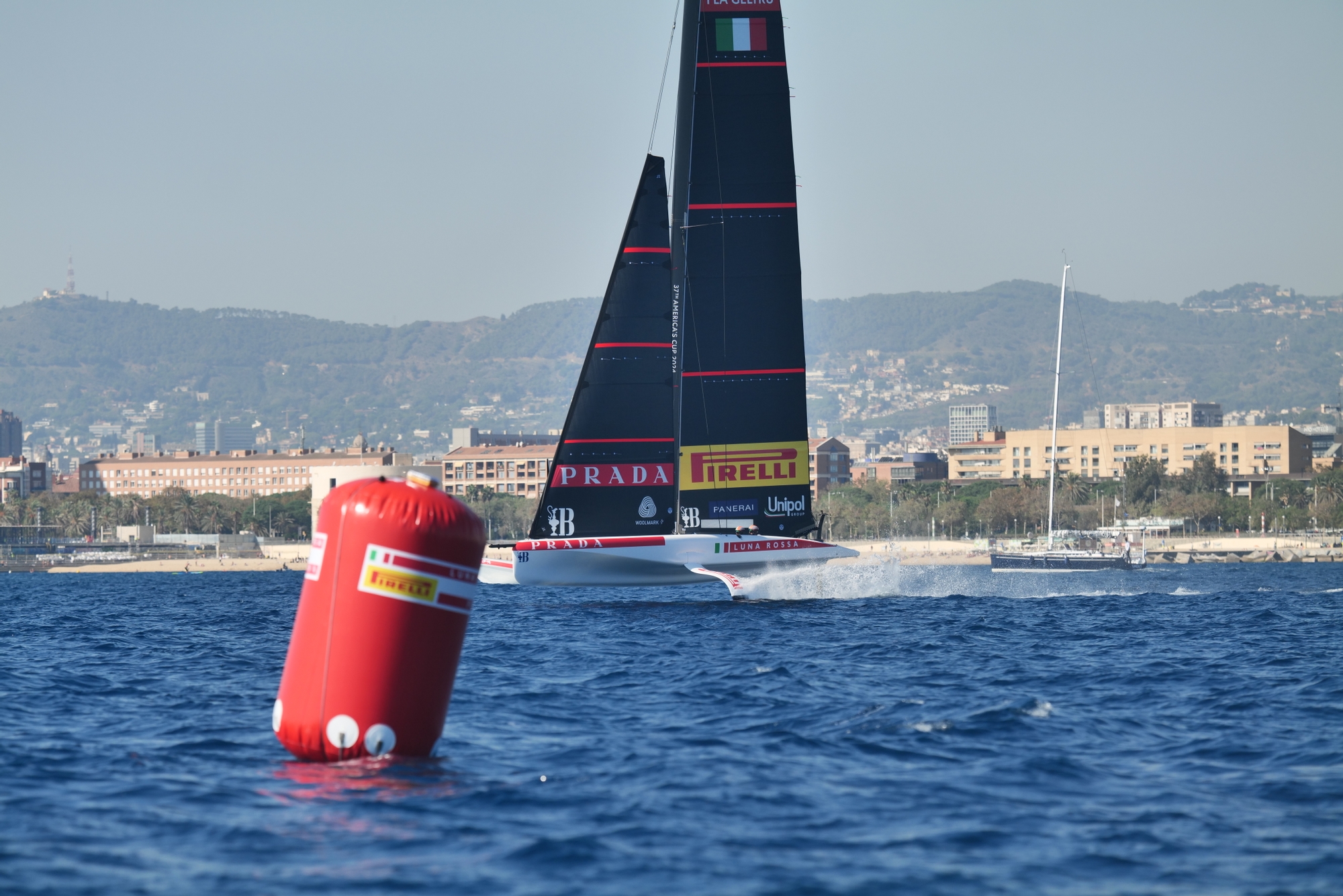
What we saw in the first Preliminary Regatta was Orient Express Racing Team with the wily duo of Quentin Delapierre and Kevin Peponnet taking the port tack flyer off the start line in an attempt not only to sail their own race in relatively clear air but also to try and eliminate one tack up the beat. By and large the tactic paid and by the second day, others were doing it too, so the port tack start is clearly one to hone and put in the armoury on a packed AC40 start line.
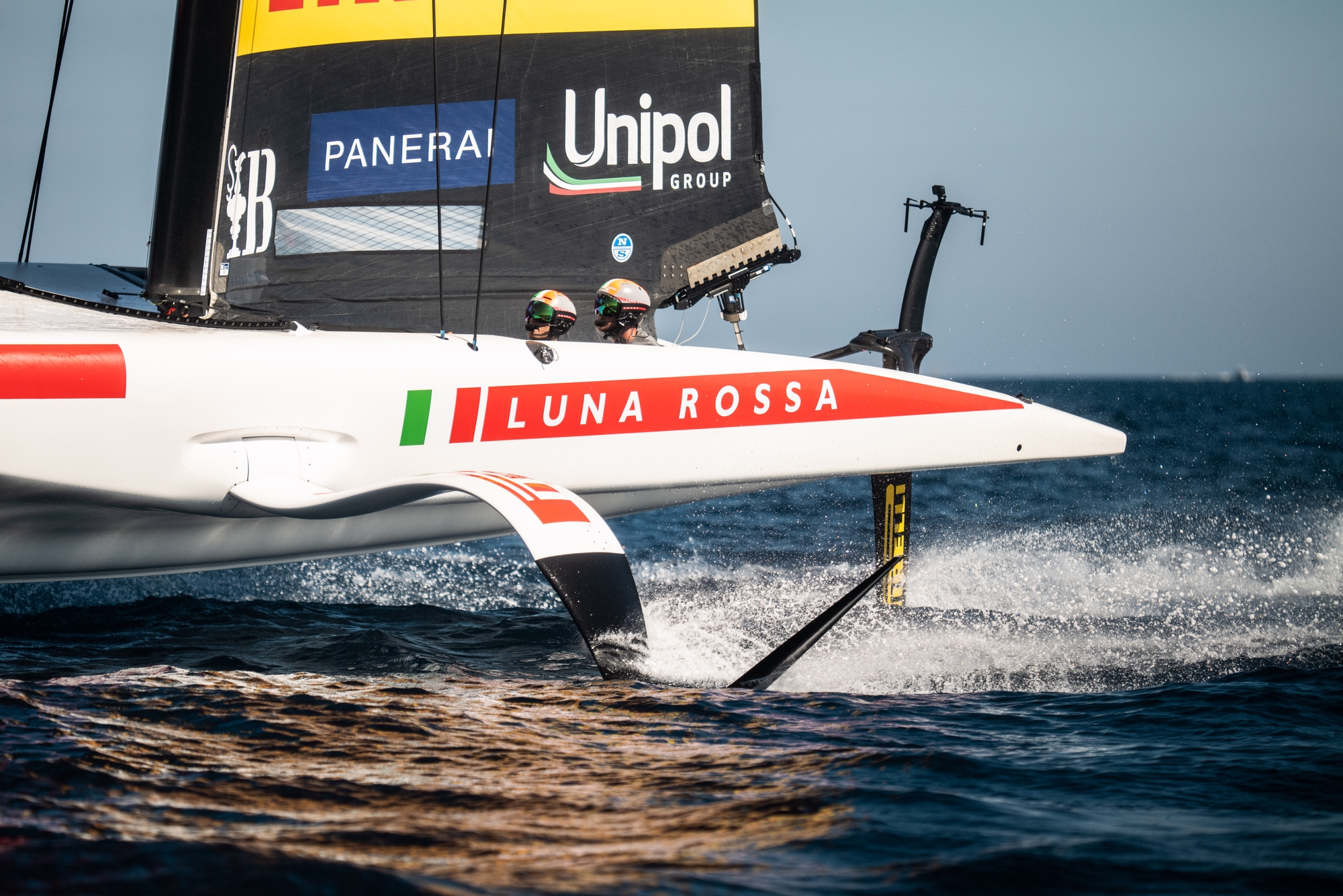
Time and again, ‘Rugi’ and Marco came at the line, killing speed and distance on the final run-in with the big scallops to leeward that always dramatically increase ride height before the auto-pilot kicks-in, the bow goes down as the helm steers to the upwind course, and the AC40 accelerates like a Tesla. Trimming now is such a fine art and Vittorio Bissaro was leading the trim team, keeping the power on and Luna Rossa looking absolutely effortless in flight and smooth through the tacks and gybes. The Italians have serious muscle memory from their extensive work with their LEQ12 in Cagliari and their board-drops are a work of co-ordination fine art with the foil immersing beautifully on the gybes as the helm dials away to give the maximum entry and exit speed.
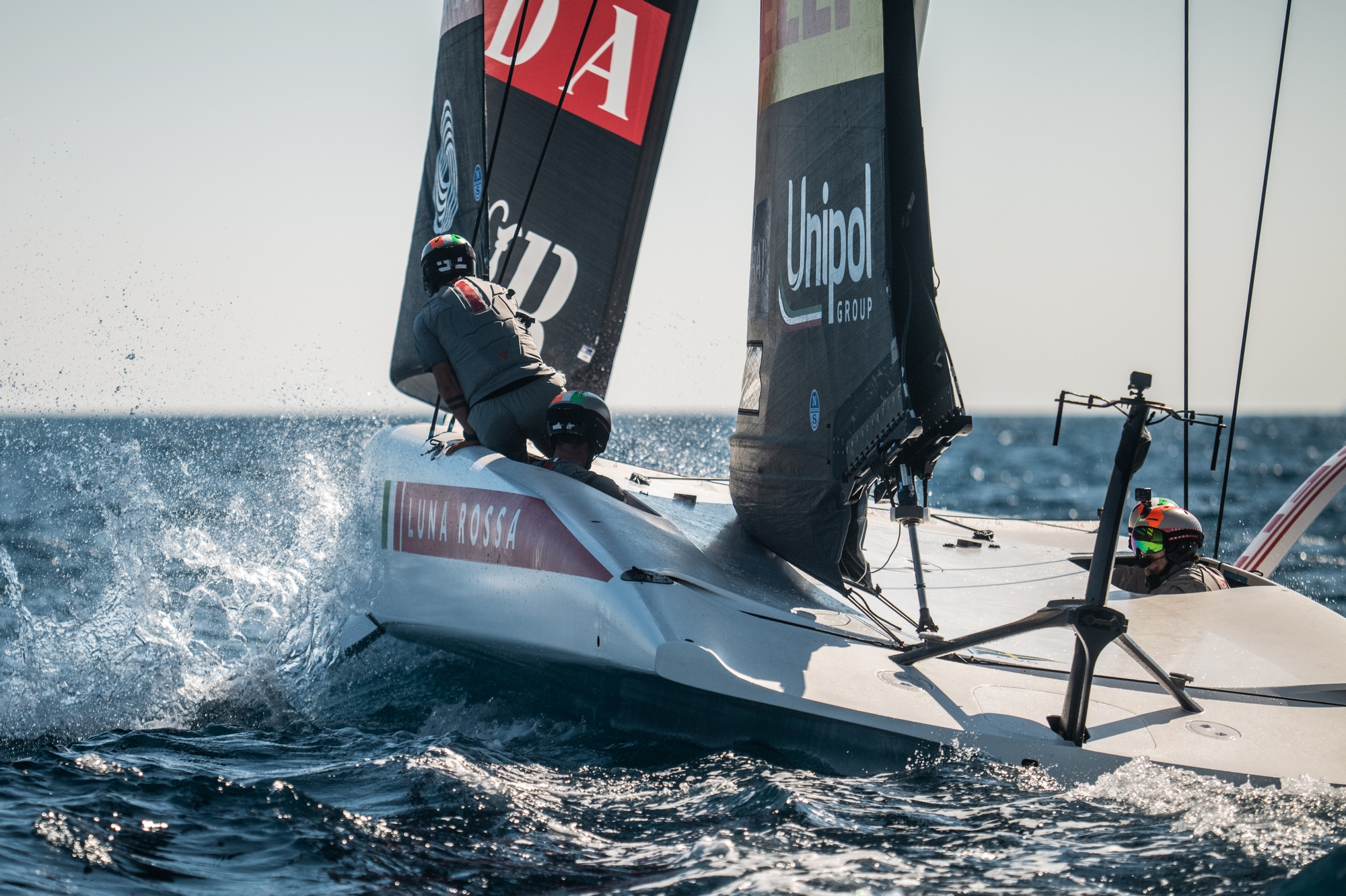
A lot of this wonderful co-ordination is down to some brilliant coaching and Jacopo Plazzi has done a superb job with the team in recent months. Speaking afterwards he contextualised the cross-training from the LEQ12 to the AC40, saying: “In the end it’s the same boat concept so there's a lot of learnings that you can apply from here to there and from there to here. It's also quite nice to see how the different teams approach the same problem with the AC40 and different solutions to the same boat so we're learning a lot here that we can apply there and a lot there you know we apply here but really we're trying to develop the AC75 for the Cup.”
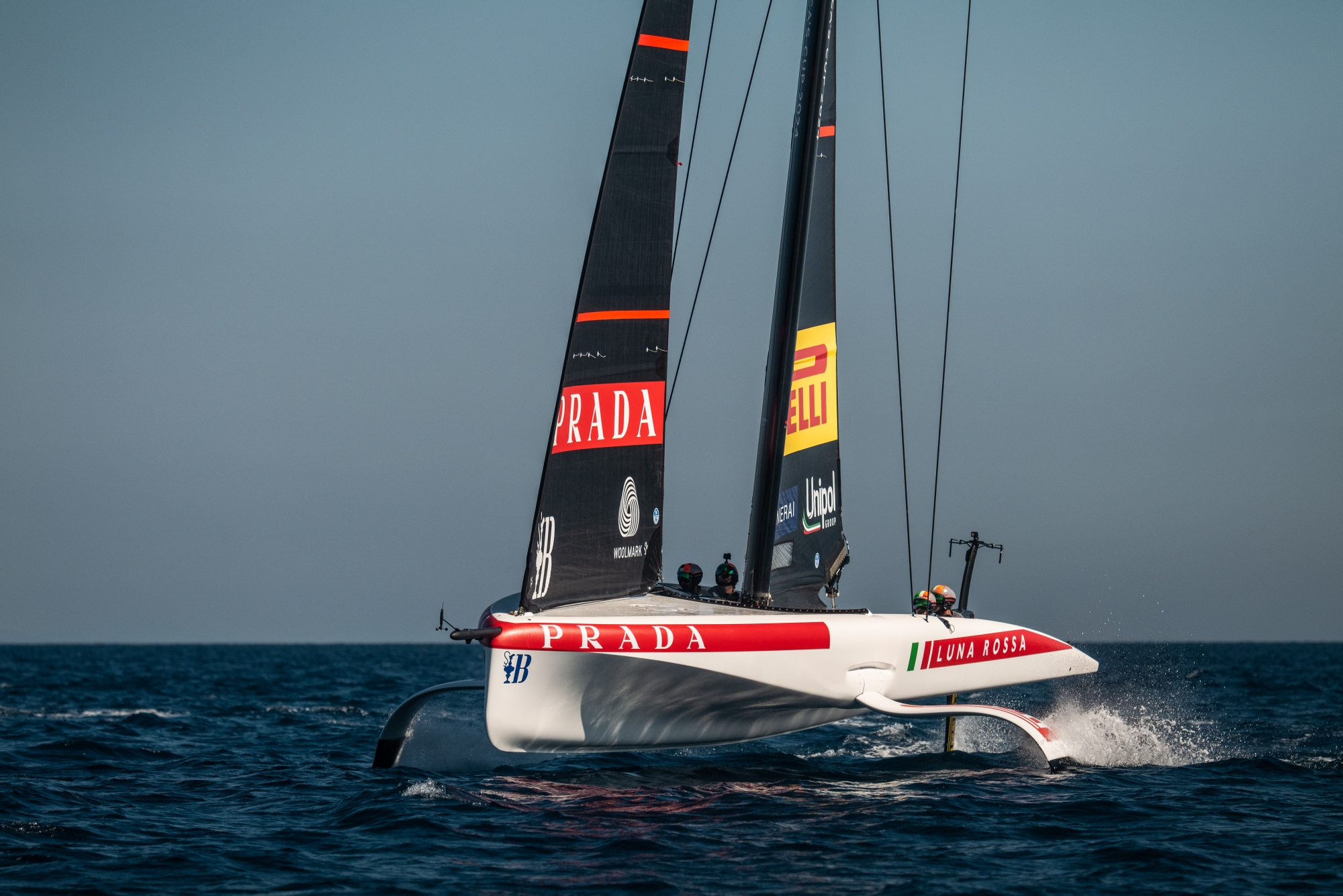
And Jacopo also spoke about Jeddah, saying: “We don't have a lot of experience there, obviously nobody’s ever raced in Jeddah, but it seems like it's possible to get a solid breeze and quite flat water so today was probably a very good example…I mean we’re definitely trying to improve everything that is race related so the process in a racing week and how we brief/debrief on the coaching side on those days and prepare for the racing environment because in the end we don't have a lot of opportunities before the Challenger Selection Series here (in Barcelona) itself.”
Luna Rossa executed a solid near five-hour block of training with the one design mainsail and J2 jib flying throughout. On this form, and perhaps with this helming combination, the Italians could be a hot tip to go deep at the Jeddah Preliminary Regatta.
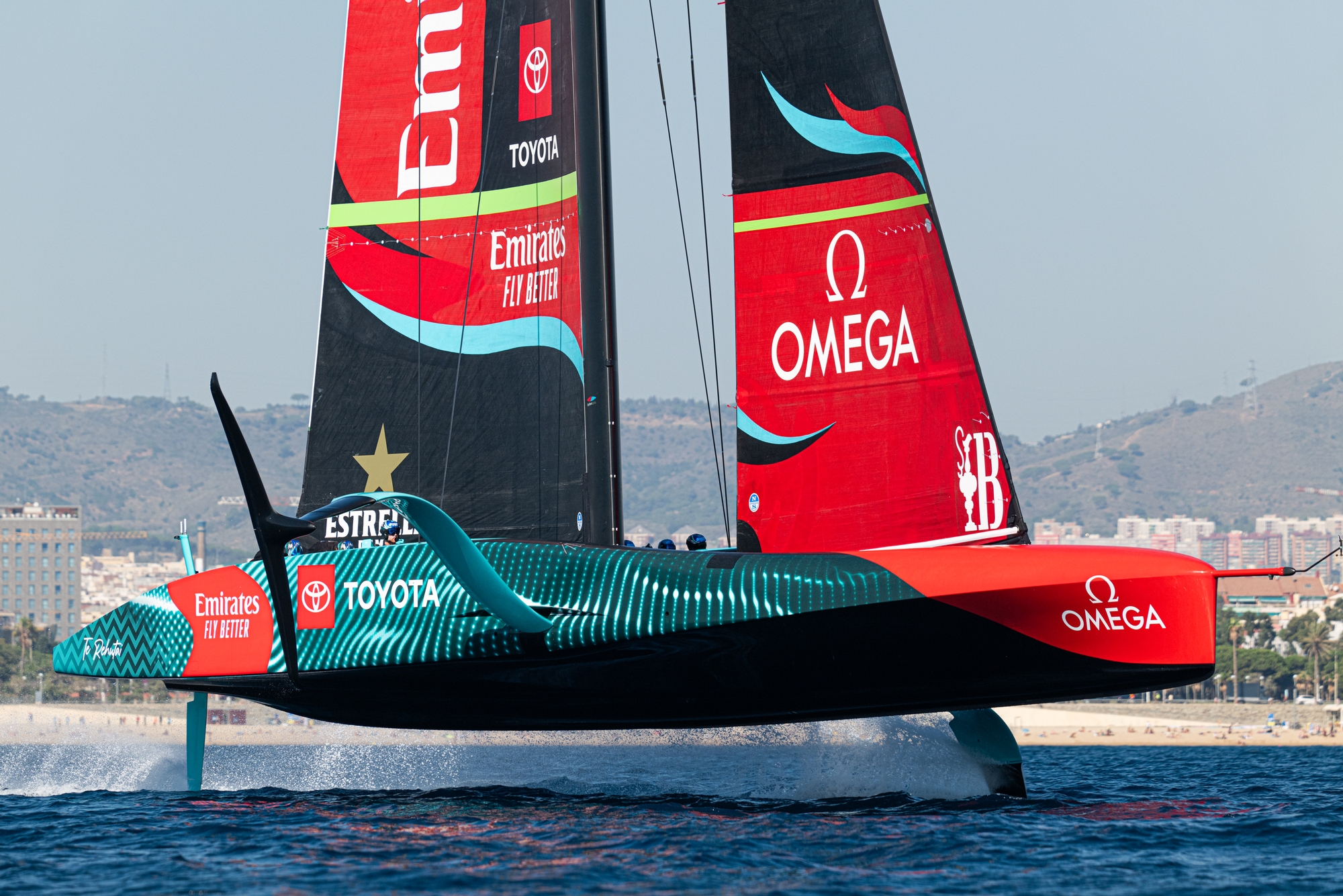
Elsewhere on a busy Barceloneta beachfront, Emirates Team New Zealand and Alinghi Red Bull Racing were busy reminding everyone of the level that will be required in the AC75’s come the summer of 2024 with both showing devastating form. The Kiwis docked out early to experience life in a building breeze, mixing things up from their usual and well-established training days. They too, had marks in the water, set up to mimic race conditions and went through their usual shadow-boxing pre-start before launching hard and hitting the virtual laps.
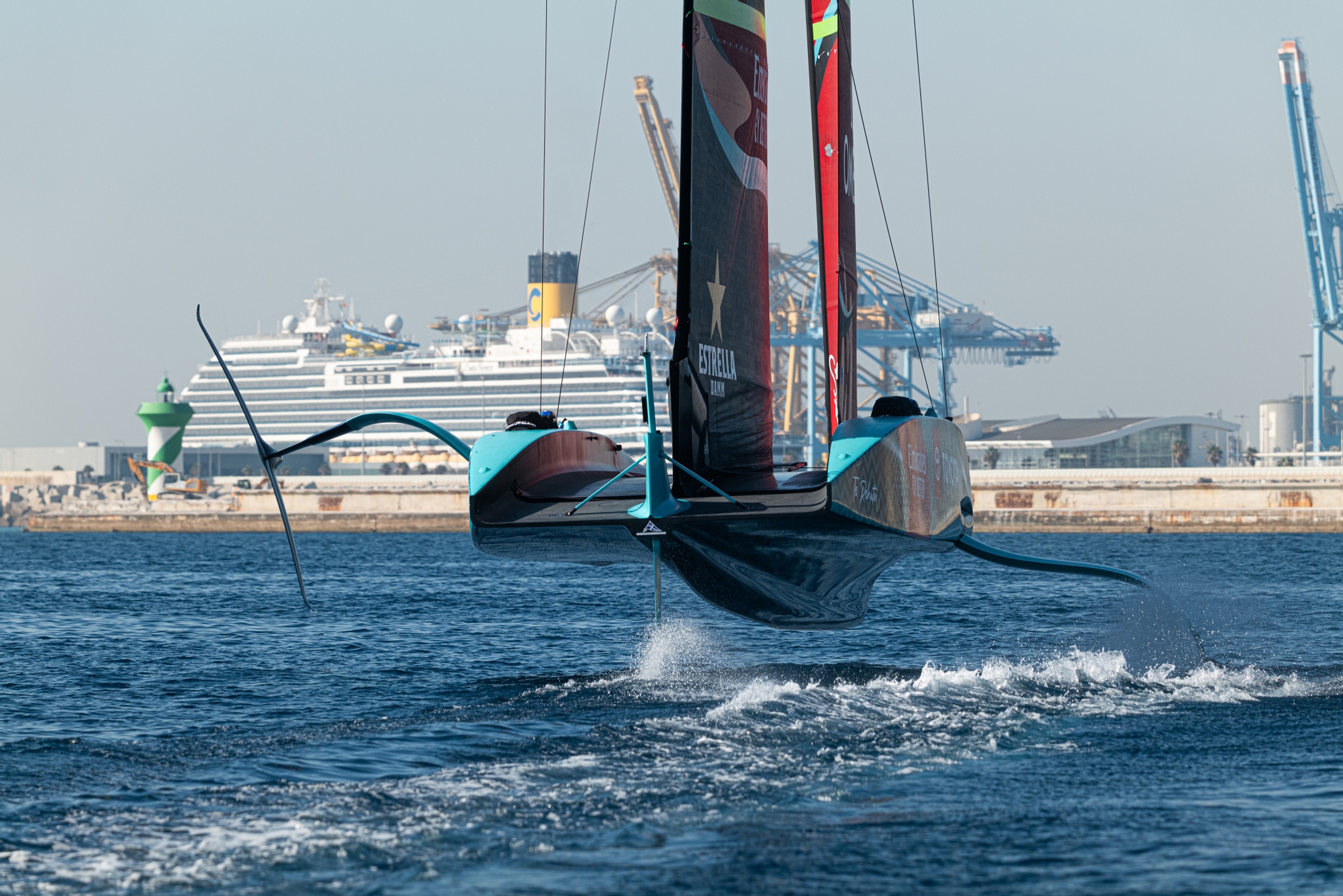
Impressive, controlled, fast sailing again from the Kiwis but equally impressive was their performance in the light airs at the beginning of the day where after a tow-up initially, they stayed on the foils for almost an hour in sub 7 knot conditions that Nathan Outteridge described afterwards, saying: “As soon as we came down to like the Olympic Port where the wind was a bit stronger we just tried to sail and keep it on the foil and yeah when we did stop the grinders did remind us how many minutes and seconds we've been sailing for (!) but we just thought it was so nice to be back on the biggest sails and sailing in lighter winds and yeah just kept sailing until someone told us to stop.”
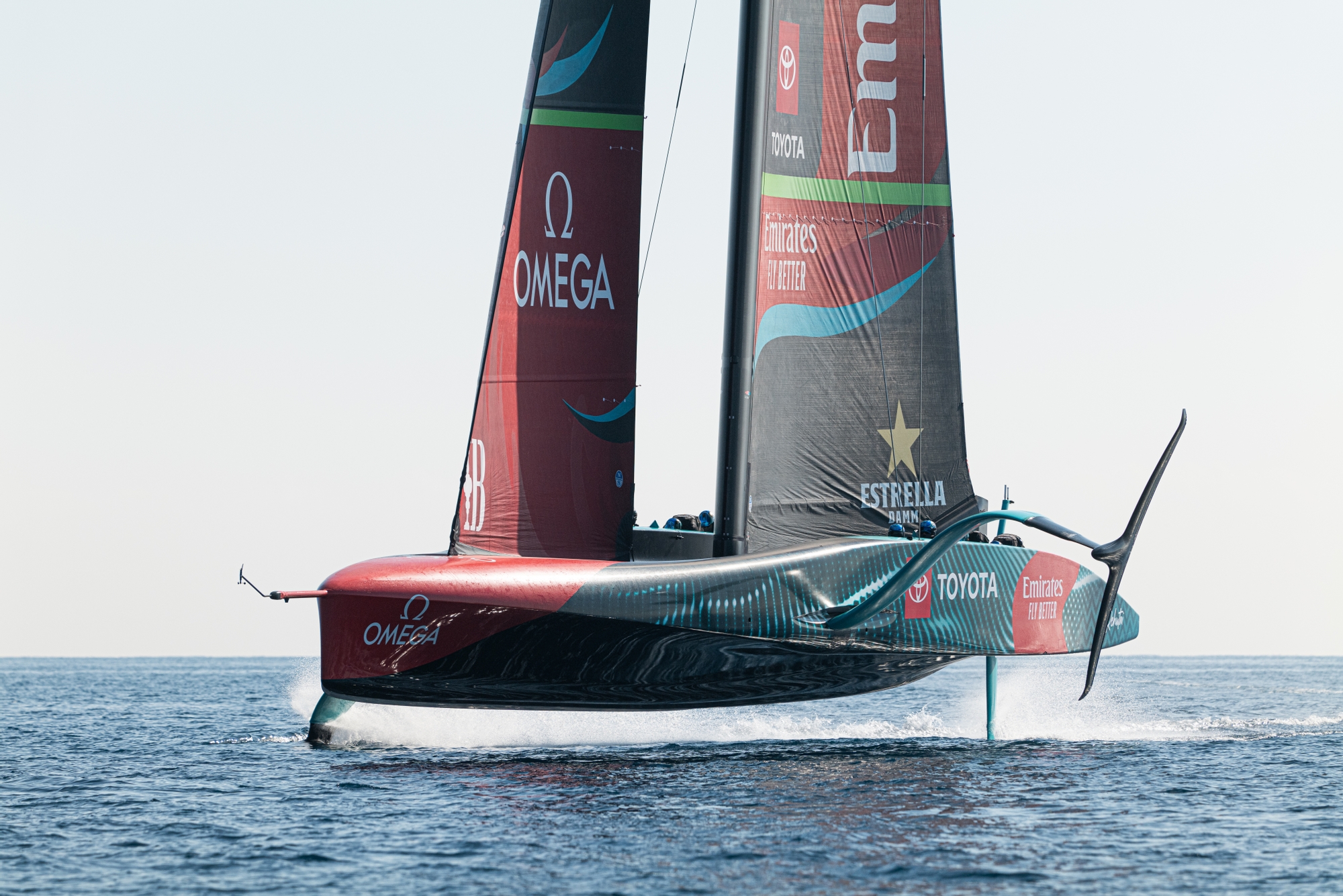
A jib code skip from the J1 to the J3, set the tone with the team fully into range comparison as Nathan commented: “We were just trying to work out if you switch up a code each stop or if you just make a big jump and with the forecast expected to build the way it was it was probably the most efficient way to skip a sail code and it worked out quite nicely we were pretty nicely in range on that sail and it's always nice to see the sail at the bottom and the top end of the range to so we got to do a bit of that on the J3.”
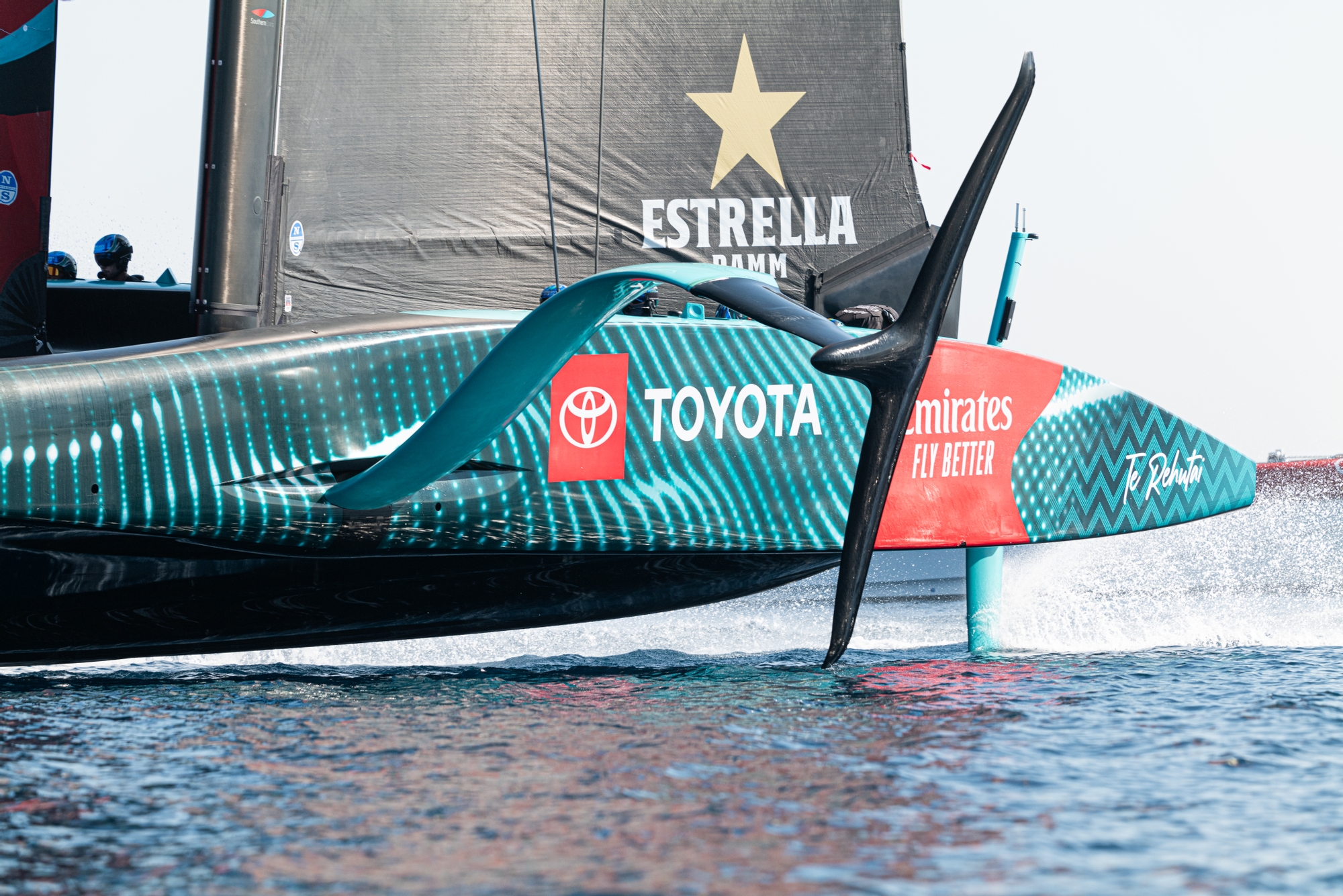
And he summed up the day and the Kiwis’ week saying: “It's been a really good week and it's interesting the weather here how you get some really nice days that we've had the last three days where it's just mint sailing conditions and been really flat water which has been a bit of a surprise when you look at historical data, but looks like when we’re back next week there could be some waves around and hopefully we can see what the sea conditions are like when we do get weather systems that you know suddenly come into autumn to contend with. So a couple more weeks after we get back and yeah it’s been good to be up here.”
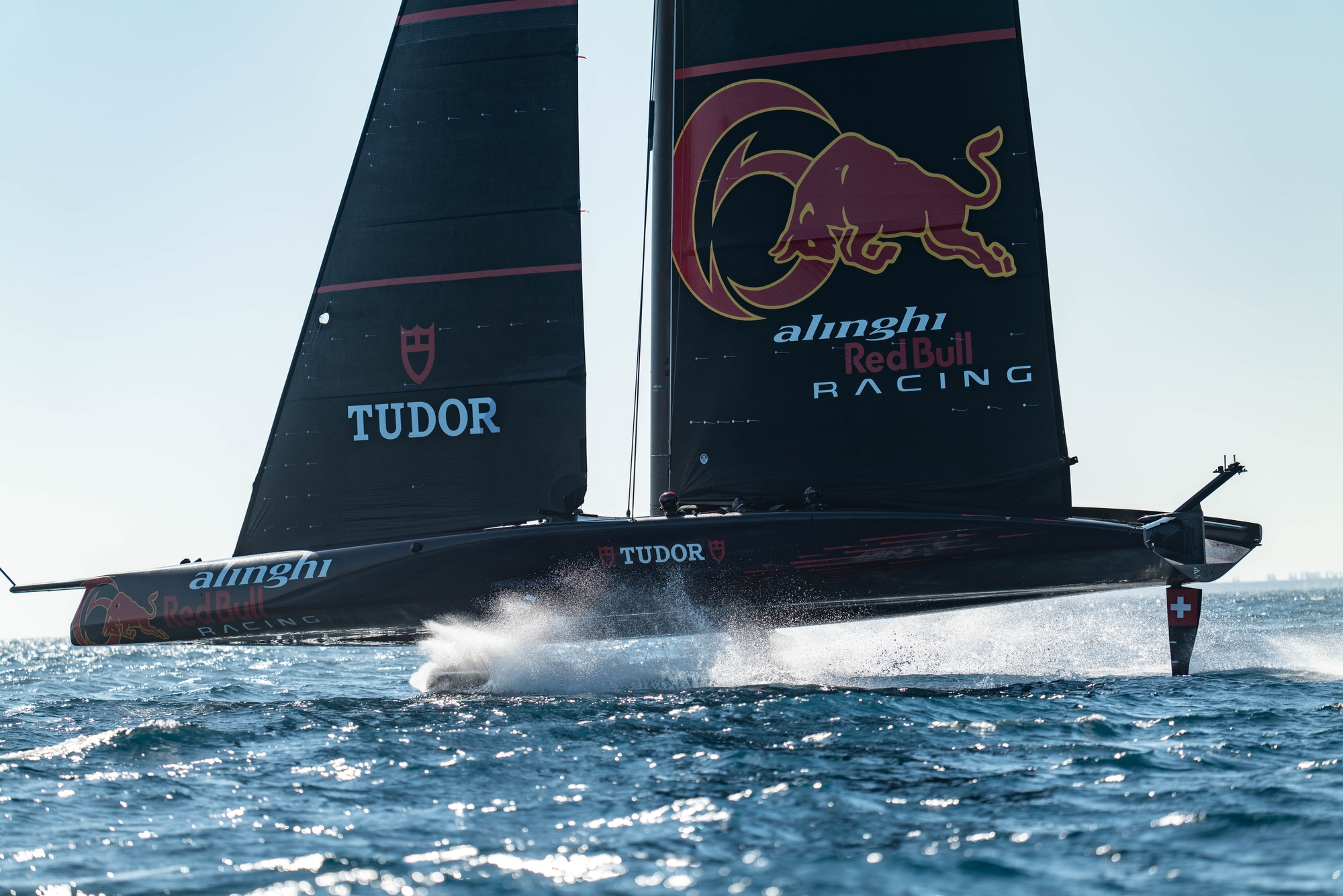
Alinghi Red Bull Racing were looking super impressive again in ‘BoatZero’ with the team dancing the fine-line on flight through the tacks and gybes but really putting the pedal to the floor up and down the beachfront and often in range of Emirates Team New Zealand and Luna Rossa Prada Pirelli. The growing sense of confidence in the team around the AC75 is palpable with big commitment in the gybes and near-perfect transitions in the tacks. A 94% success rate foil-to-foil tells a story within itself whilst over a virtual course, they looked committed and on-it all day. Impressive performance with plenty of cant adjustment, moding and ride heights observed throughout the near five-hour session.
Speaking afterwards Luc Dubois one of the highly experienced and long standing members of the Performance Engineering Team that looks at sail design gave a terrific interview saying: “This week was good to get back into it, the conditions are great so we're just practising a little bit of everything…it's just kind of getting back into the rhythm with the AC75, conditions are flat, we had different wind speeds so far, so it’s a good week.”
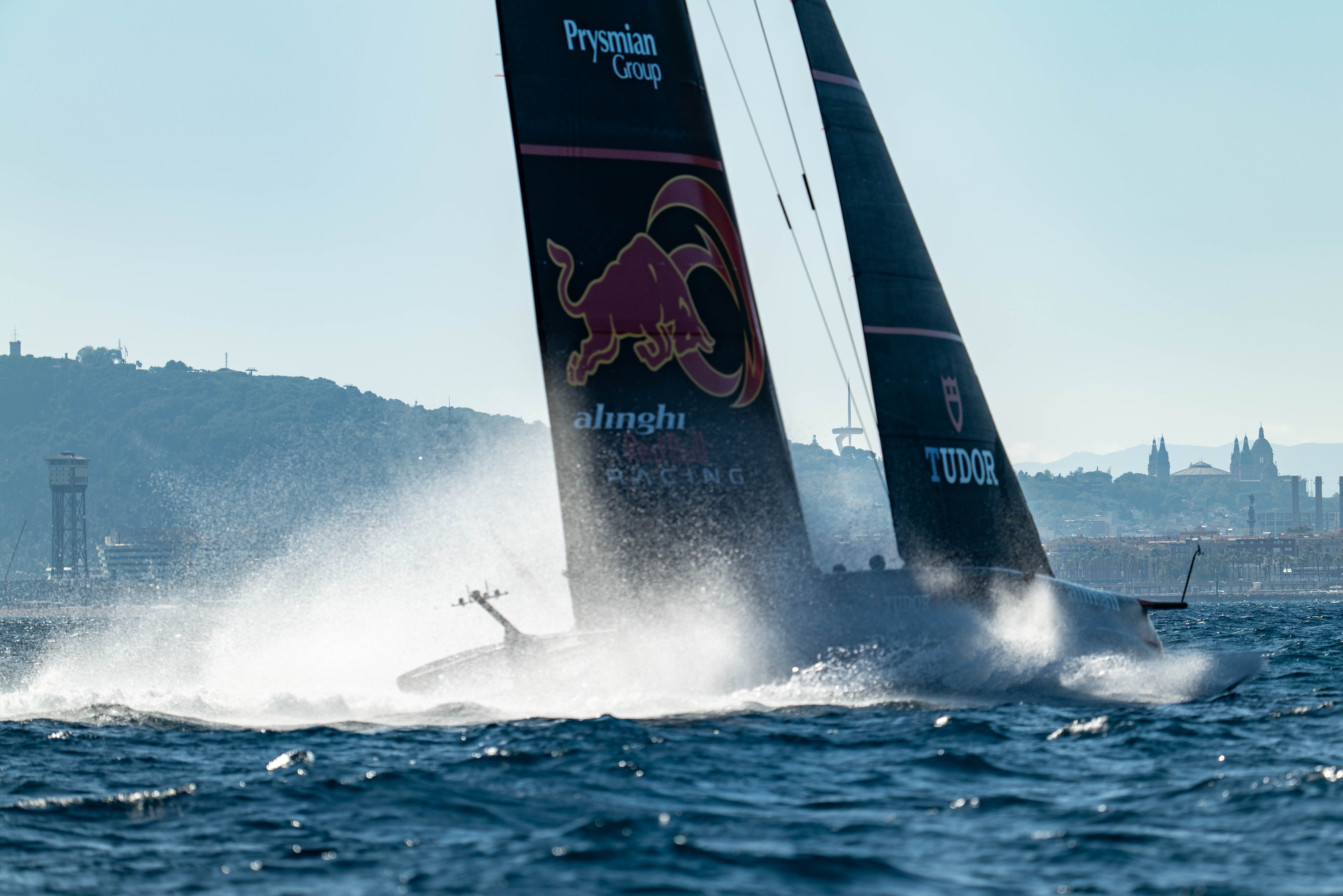
With the Swiss unable to change sails due to componentry restrictions, clearly the aero side of the development is not a huge focus for now. That will change in time but talking about whether the sails are standing up okay to the constant demands of the sailors and in particular after the jib clew blow-out from last week, Luc Dubois was realistic when asked about performance saying: “I think our sail makers know that pretty well so they can always make miracles and that's what they do, sure the sails are little bit beat up by now you know they’re old sails and things like that happen from time to time but no I think they're doing a great job in keeping the inventory up to speed….By now they're pretty beat up sails and we're more trying to keep them in shape than really trying to extract the little last performance differences between them so you know it's more kind of getting used to picking up the right sail for the right wind conditions more than anything else at this stage.”
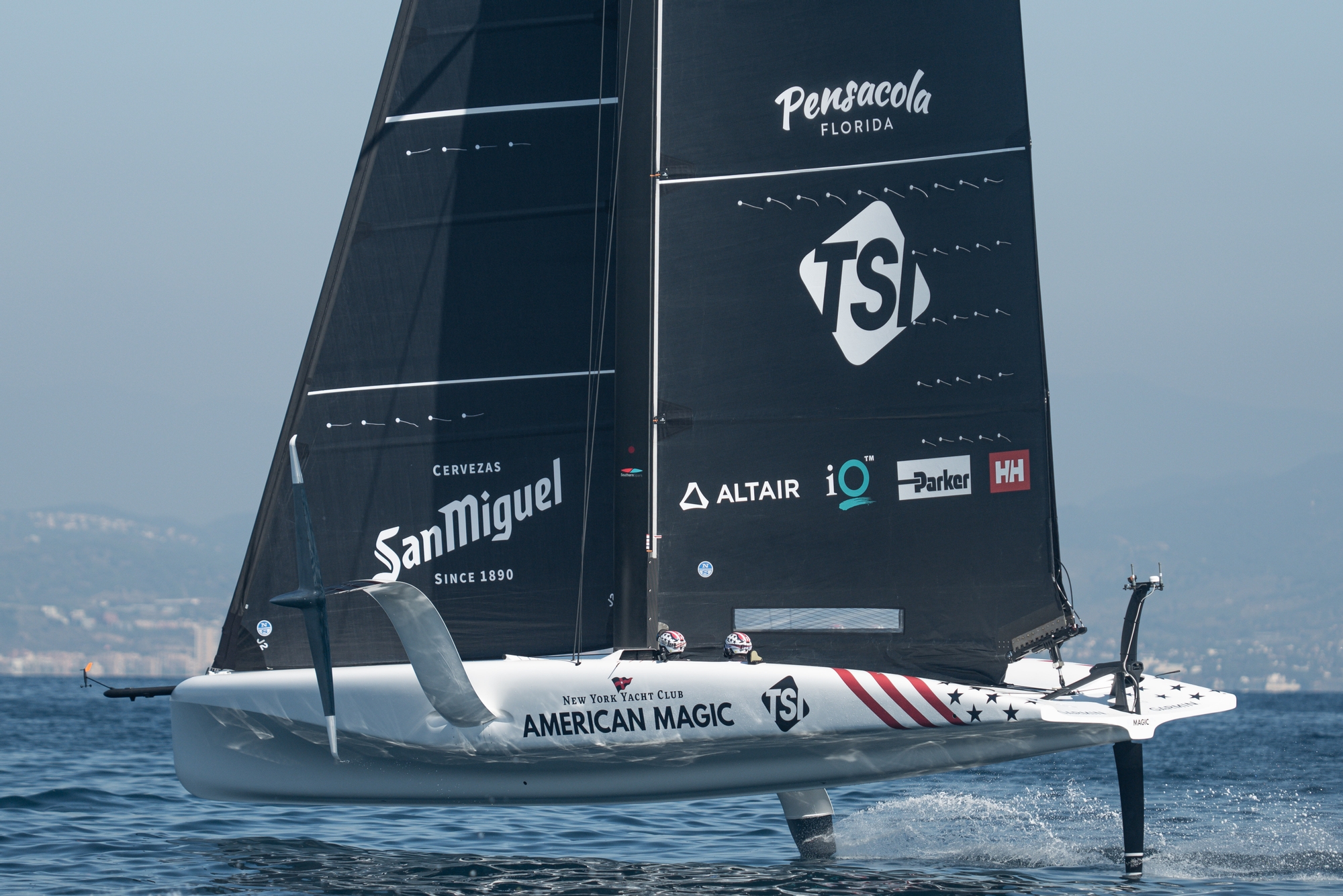
NYYC American Magic meanwhile upped their race intensity with an electric session of two-boat action bringing boundaries and tight manoeuvres into play to put pressure on the sailors whilst still in full evaluation mode with their foils.
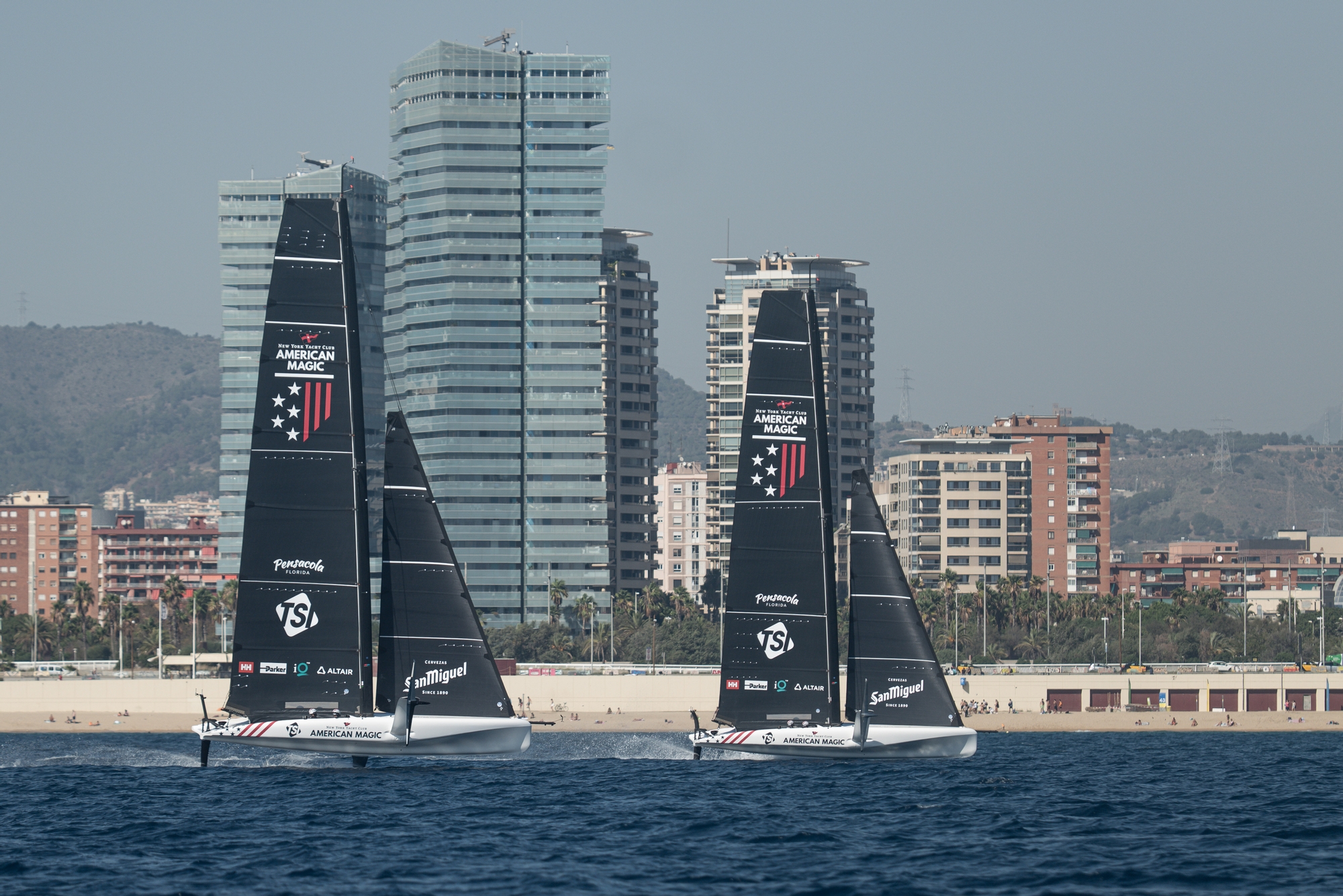
Harry Melges, one of the real up and coming stars of this America’s Cup cycle, gave a great analysis saying: “Today was an awesome day, it was kind of a typical Barcelona sea breeze that didn't pick up quite as much as we thought it would and we were mainly testing our foils against each other on a racecourse setting with quite a long course - I think we were doing like two-mile beats maybe.”
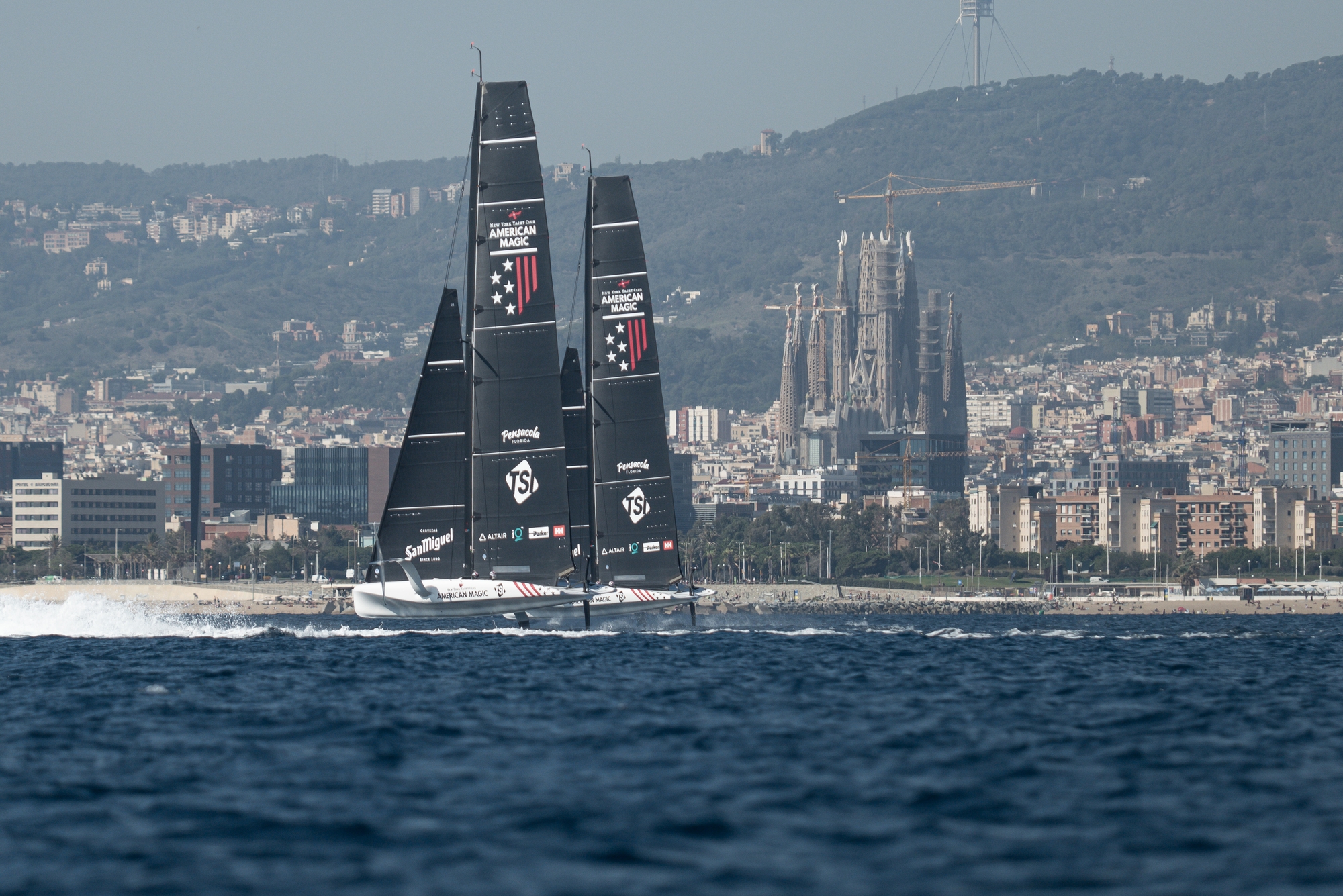
Talking about the foil evaluation, Harry added: “I don't think we're quite sure, you go back and look at the data and see how it all shook out but obviously there's a conversation between small foils and big foils and how that plays into a racecourse setting and when you get in tight tactical situations, and you're having to tack and gybe a lot and do complex manoeuvres it's not always about who's fast in a straight line…it definitely was quite unstable today, the wind was pretty shifty out there and pretty big lulls and big gusts so it’s not all in the performance of the boat, it's also about picking the right spots on the racecourse even though the boundaries are in place and the course is quite narrow.” A racer’s answer and spot on.
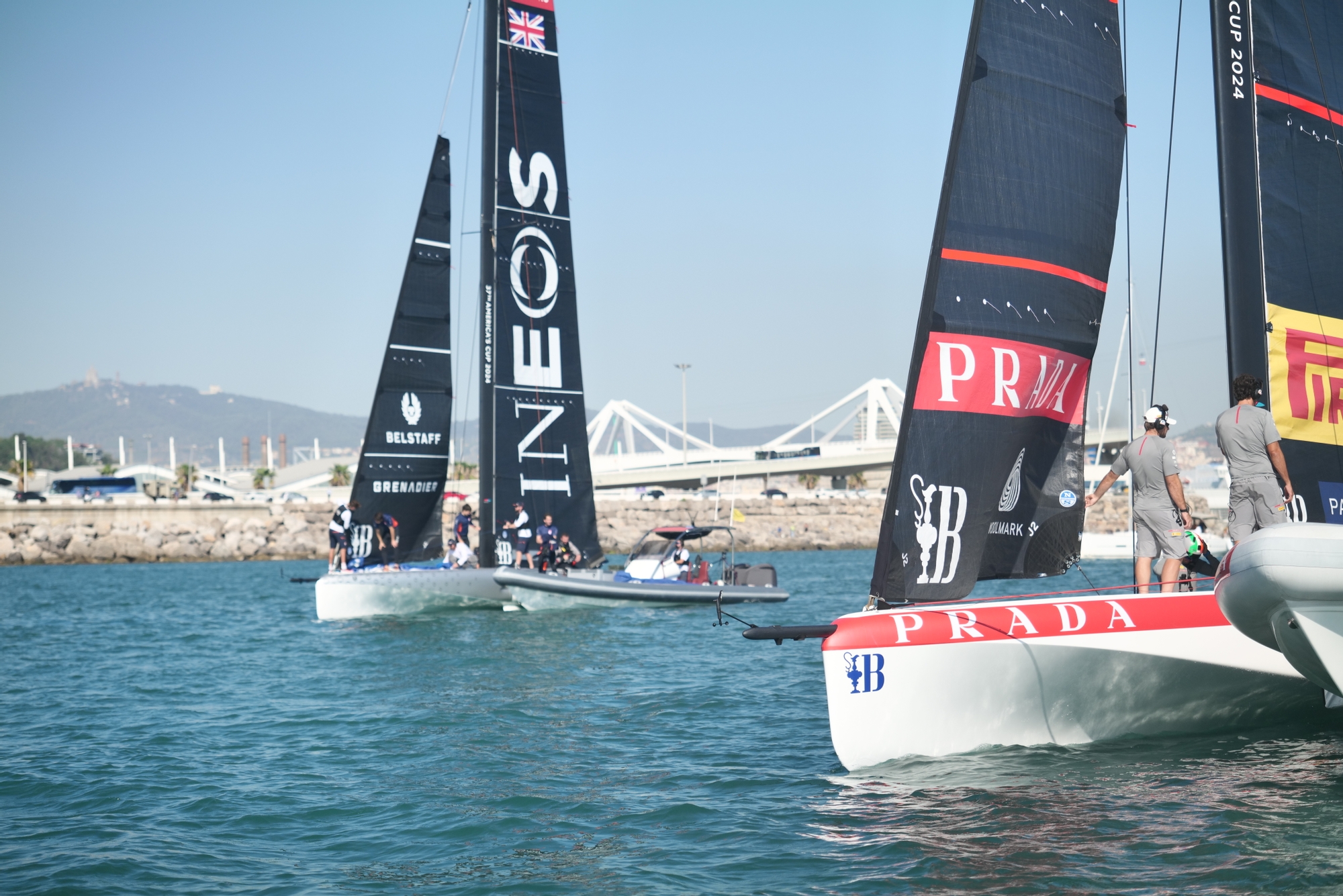
INEOS Britannia and Orient Express Racing Team were both out in their one-design AC40s with no recon following them although they were, at times, picked up on both video and photo crossing with the other teams on what was a busy Barcelona day along the beachfront. Both teams looked to be revelling in the conditions in the short glimpses caught on camera as they prepare for the upcoming Preliminary Regatta in Jeddah, Saudi Arabia at the end of November. (Magnus Wheatley)
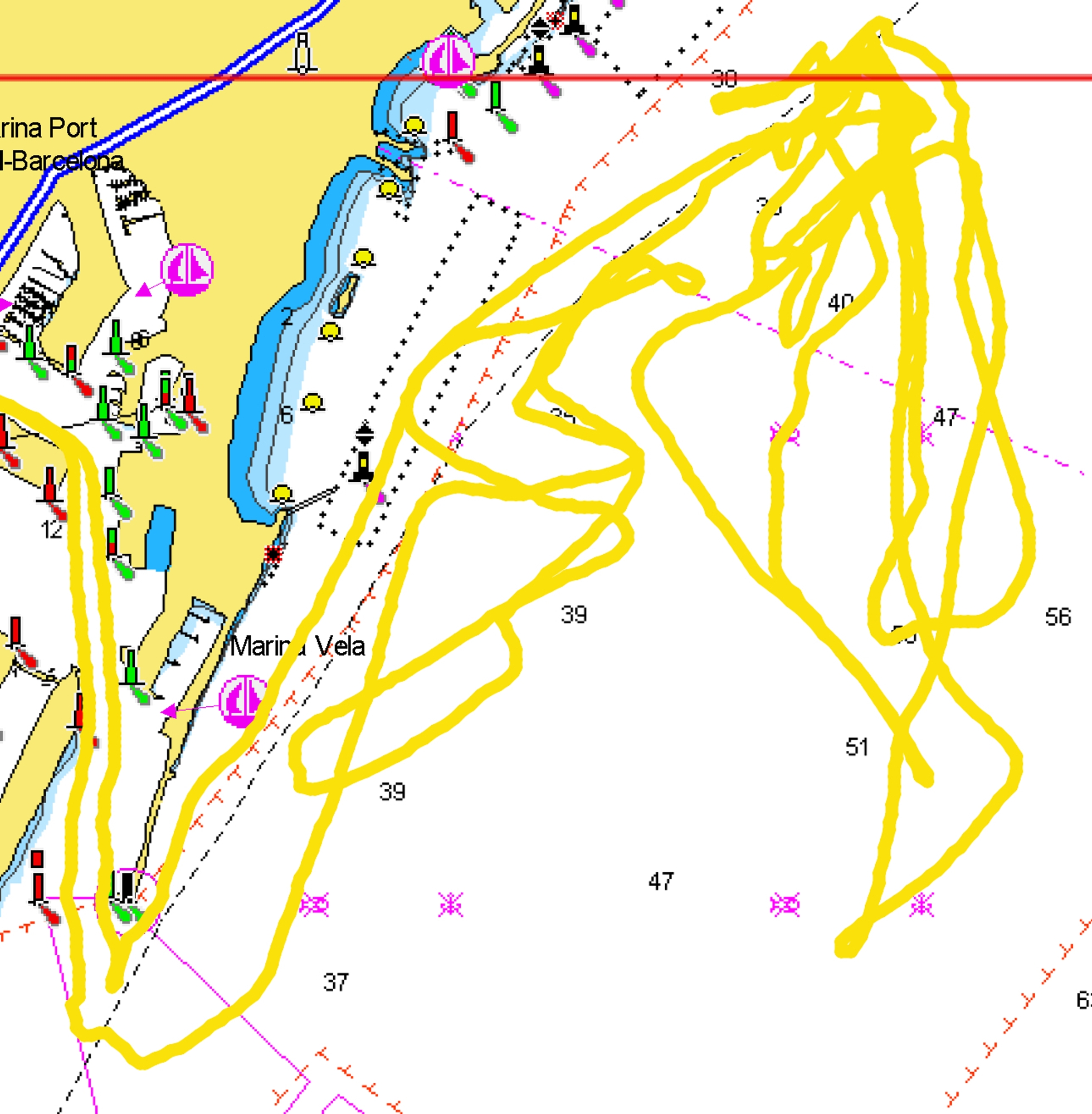
On-Water Recon Unit Report – Emirates Team New Zealand: Emirates Team New Zealand third and final day of sailing for this week started with an 1100 dock-out that saw the Kiwi AC75 out of the harbour with M3-1 mainsail and J1-6 headsail up and ready to sail at 1115.
With the southerly wind at just 6 knots (as measured from the recon boat) and super flat water, the team opted for a towed take off. With the boat flying on two foils downwind at 30 knots the tow turned to the right and the AC75 lifted its starboard windward foil as the tow was released at an estimated true wind angle of 80 degrees. With the boat up and foiling now in no more than 7 knots of breeze the crew put it through a series of tacks and gybes while the support team hustled to set two start marks in the approximate area of the 37th America's Cup racecourse. Keeping the boat in the air looked precarious at times with the trimmers often having to resort to close to maximum windward mainsail traveller to stay airborne – particularly downwind.
Soon though the breeze began to build and by 1145 when the crew performed their first practice start at the pin end of the line the breeze was up to 7-8 knots and the boat looked much more comfortable in flight. After a second practice start and a full windward leeward lap the crew stopped at 1211 to change headsails to the J3-6 (wind now at 9 knots). This was the first stop since the tow-up – a flight time of 50 minutes. The yacht was off again at 1230 with a comfortable self-take-off. Once again, the team made two starts (including prestart manoeuvring, with the second one followed by a full windward leeward lap.)
At 1250 we saw a 10-minute stop to rotate the cyclors before another identical pair of starts plus windward leeward lap. A food break at 1342 (when the wind was at 11-12 knots) was followed by two more practice starts and a full windward leeward lap, before a long multi-tack beat back to the mouth of the harbour for a stop at 1410. Sails were dropped by 1420 with the boat back on the dock at 1435. The team's next scheduled sailing day is Monday October 16.
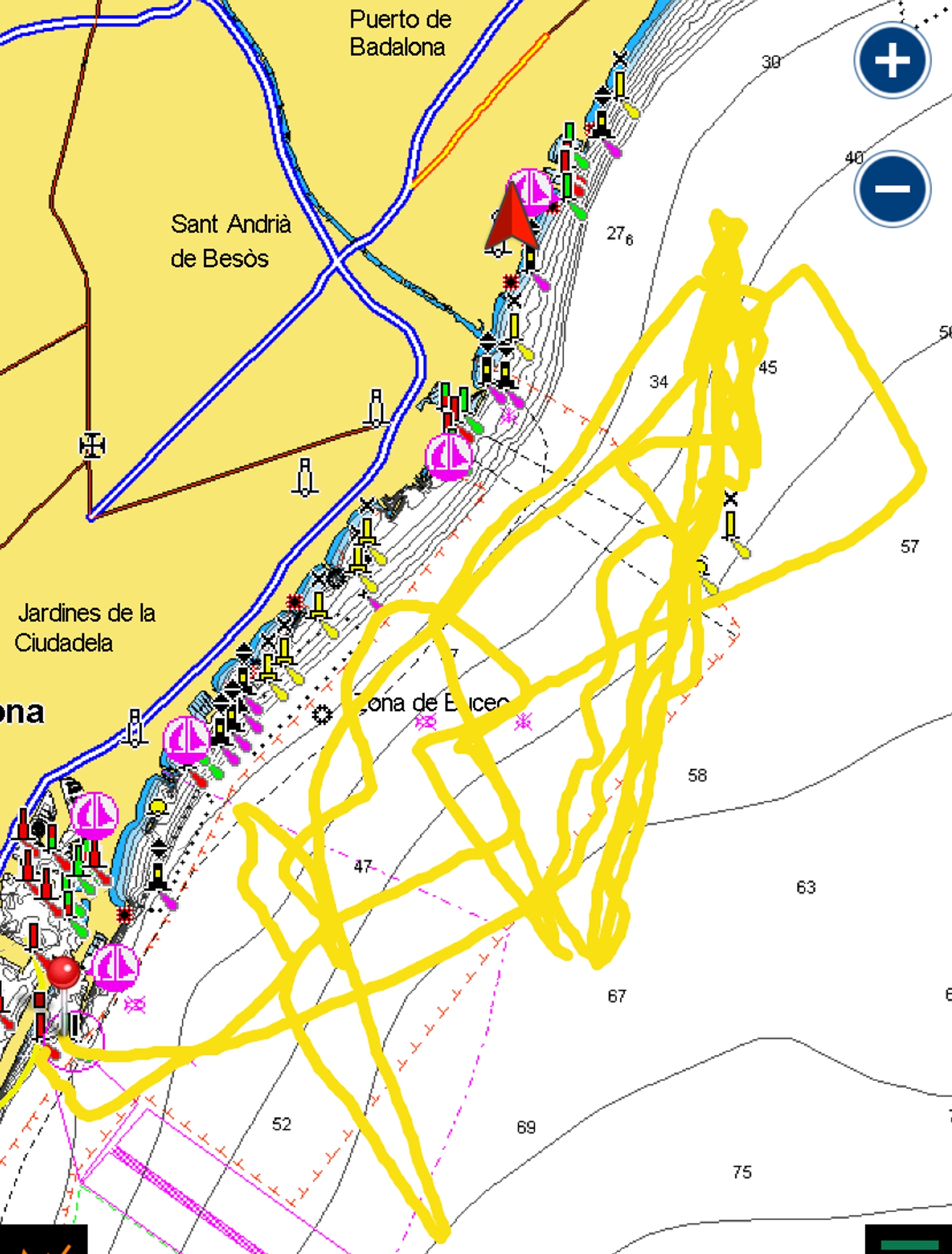
On-Water Recon Unit Report – NYYC American Magic: NYYC AM rolled out Magic at 09.45 and America at 10:25. Both AC40s on LEQ12 mode, with the same foils’ configuration as the past two days and last week.
Magic was craned to the water at 10:20, and then America followed at 10:50. Both boats docked out at 11:55, as planned.
The same one-design main sails as yesterday were selected again for both boats. The MN3 on America and the MN2 on Magic, which were hoisted at 12:05 while coming out of the port.
Once out, one-design J2s were hoisted at 12:10.
The day started with America and Magic speed testing, switching positions to windward and leeward, for approximately one hour. Two long upwinds and downwinds were executed. Magic, once more, was slightly faster on port tack when sailing upwind standing on foil #4 vs America on foil #2. However, in contrast to other days, on starboard tack when sailing upwind Magic´s performance on foil #1 was much better, being completely evened on speed and angle vs America standing on foil #3.
On the two downwinds, Magic´s performance was also better compared to previous days, especially on starboard tack in which they were faster and lower at times. Remember that in most other days, America was lower, same speed, achieving a stronger downwind VMG, with Tom explaining that America gives more chances to play the modes and with “something extra”.
Reasons? Possibly, Magic´s foils achieve a better performance than America´s in this medium wind conditions of approximately 11 to 14 knots of TWS, flat water, sailing on their J2’s, at whichever boat speeds they sailed today.
From 13:35 till 13:45 the team took a break and then marks were set.
An upwind-downwind course of approximately two times the distance of a standard racecourse was anchored, with virtual boundaries. It seemed like the intention was to test the foils performance in racing mode, with boundaries and being forced to tack and gybe, simulating racing dynamics. Both boats did ten tacks per upwind leg, and eight gybes on each downwind.
Three one-lap races were run, doing rabbit starts. Magic was first on every mark rounding and won the three races. The gap difference in between both boats was a bit larger on racing format, than when speed testing in a straight line with no manoeuvres and boundaries. In between race two and three, there was another break from 14:34 till 15:00.
At 15:40 a fourth upwind was carried out in which Magic was also first at the top mark.
Then Magic headed back to the base, while America stayed one hour longer training on their own.
Magic entered the port and lowered sails at 16:20, docked at 16:25 and was craned out at 17.03. America followed the same routine, one hour behind approximately. Another solid two-boat testing day for NYYC AM with medium wind conditions. Sebastian Peri Brusa – Recon on NYYC AM
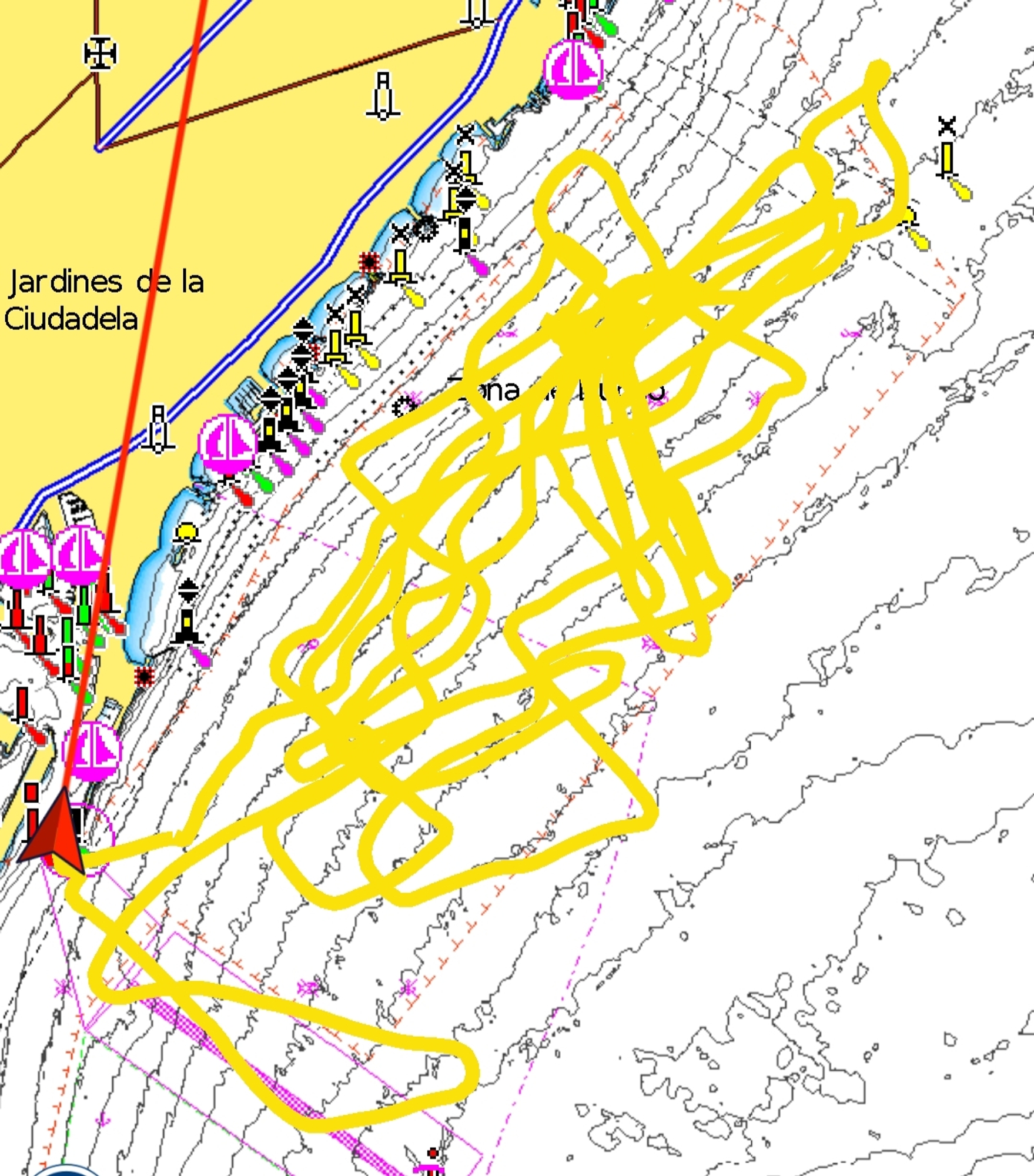
On-Water Recon Unit Report – Alinghi Red Bull Racing: The Swiss had a productive sailing session focused on testing different upwind modes, cant angles, manoeuvres and pre-starts.
The team rolled out their AC75 at 10:00h, the yacht was craned in, and pre-sailing checks were carried out, with engineers onboard testing hydraulics on the mast and both foils.
The team docked out at 12:15h, hoisting the M2-2R mainsail and J3-1R headsail inside the port and being towed out by 12:42h. The wind conditions outside were 9knts from 228º with clear skies and fairly flat sea state. They followed the same pattern though all the session, focusing on manoeuvres with flat sea state, pre-starts, rounding marks and race course.
They started sailing by the port entrance until touching down in the very first tack, then they took advantage of checking on the main traveller. After sailing in displacement mode, they did one leg downwind-upwind, seemingly struggling because of not having enough power on the headsail. After touching-down, they dropped the jib and hoisted it again, followed by 8 gybes on a short downwind.
At 13:42h, the team did a 40 minute run, foiling with different modes and cant angle, consisting of nineteen fully foiling manoeuvres at eleven knots. They stopped the AC75 near La Barceloneta Beach and the chase boat approached to do a cyclor swap.
At 15:08h, located north of Luna Rossa's marks, they started with the first pre-start, sharing marks with the youth and woman's training with in their Persico 69F boats. The race course consisted of two legs upwind-downwind with a GPS mark situated windward, and giving a lot of space when rounding the starboard gate in both occasions.
Before starting the second pre-start, the J3-1R jib was substituted with a J4-1R. With a lot of traffic around, they crossed the start line and went for another two legs that lasted 20 minutes. After rounding the gate, they approached upwind by the port entrance, where they finished today's session on the water.
The day wrapped up with sails lowered at 16:45h, after which the yacht was towed back to the base, docking in at 17:05h. The team covered a total of 54 nautical miles over four hours on the water, 145min were spend sailing with 81 manoeuvres performed, 94% fully foiling.
